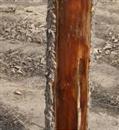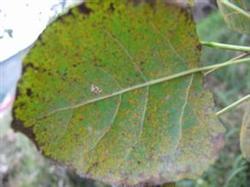Identification and control of poplar canker

The typical symptoms of poplar canker disease can be divided into two types: ulcer type and withered tip type. In the early stage of ulcerative disease, brown round or oval bark appeared in the infected tree trunk, showing waterlogged or blister-like disease spots, and there was liquid outflow under hand pressure. After the blister burst, the liquid flowed out with wine lees, the disease part shrank and sank into ulcer spots, and the cortex of the lesions became brown and rotten. The withered tip type mostly occurred in the young trees in the same year, and there were inconspicuous small spots on the trunk, showing reddish brown. 2-3 days later, the disease spot quickly surrounded the trunk, resulting in the death of the upper tip. Poplar canker pathogen usually exists in the bark in a latent state, and poplar seedlings can be infected in the nursery, and the incidence of poplar seedlings transplanted in spring is the highest. The disease begins in the middle of April every year, and the peak period is from late May to June. Prevention and control methods: do a good job in the origin quarantine and transportation quarantine of poplar seedlings in the disease area, so as to avoid planting susceptible seedlings. At the same time, strengthen fertilizer and water management, enhance the tree potential, avoid trauma, and enhance the resistance of trees. For the infected trees, methyl topiramate, carbendazim and other pesticides can be used to brush the trunk, trunk injection, root irrigation or crown spray control. Seriously diseased trees should be truncated and diseased branches and dead trees should be removed.
- Prev

Poplar bark rot
Distribution and harm of poplar skin rot, that is, poplar rot. Poplar cultivation areas occur in China, but they are mainly distributed in Northeast, Northwest, North China and other areas. It is a common and frequently-occurring disease of poplars in parks, green spaces, street trees and nurseries, which often causes a large number of street trees to die, especially the newly transplanted poplars. The disease.
- Next

Identification and Control of Black spot of Poplar
Poplar black spot, also known as poplar brown spot, the disease can infect a variety of poplar, seedlings, young trees, big trees can be susceptible, seriously affect the normal growth of trees, resulting in economic losses. Symptoms: generally occur in leaf shoots and ears, spread from top to bottom, mainly harm to leaves, disease.
Related
- Fuxing push coffee new agricultural production and marketing class: lack of small-scale processing plants
- Jujube rice field leisure farm deep ploughing Yilan for five years to create a space for organic food and play
- Nongyu Farm-A trial of organic papaya for brave women with advanced technology
- Four points for attention in the prevention and control of diseases and insect pests of edible fungi
- How to add nutrient solution to Edible Fungi
- Is there any good way to control edible fungus mites?
- Open Inoculation Technology of Edible Fungi
- Is there any clever way to use fertilizer for edible fungus in winter?
- What agents are used to kill the pathogens of edible fungi in the mushroom shed?
- Rapid drying of Edible Fungi

